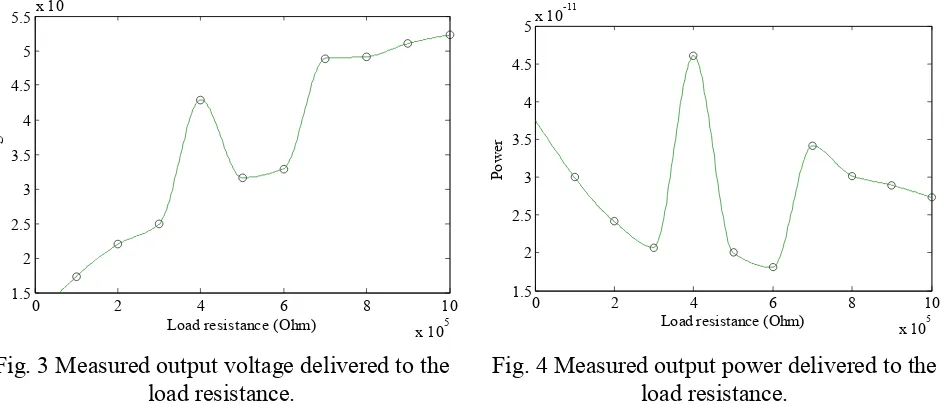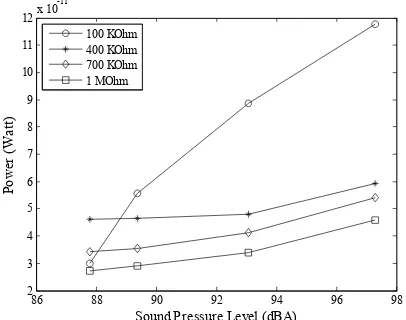Acoustic Energy Harvesting Using Flexible Panel and PVDF films:
A Preliminary Study
SIDIK Susilo
1,a*, AZMA Putra
1,b, KOK Swee Leong
1,c, MOHD Zaki Nuawi
2,d,
and NAWAL Aswan Abdul Jalil
3,e1Centre for Advanced Research on Energy, Universiti Teknikal Malaysia Melaka, Hang Tuah Jaya 76100, Durian Tunggal, Melaka, Malaysia
2Faculty of Manufacturing and Built Environment, Universiti Kebangsaan Malaysia, 43600 Bangi, Selangor, Malaysia
3Department of Manufacturing and Mechanical Engineering, Universiti Putra Malaysia, 43400 Serdang, Selangor, Malaysia
a[email protected], b[email protected], c[email protected], d[email protected], e[email protected]
Keywords: Energy harvesting, Acoustic, Flexible panel, Piezoelectric.
Abstract. Acoustic energy harvesting from ambient noise utilizing flexural vibration of a flexible panel is investigated. A flexural vibration from the panel is use to extract more energy from the ambient noise where piezoelectric materials of PVDF films are attached around the plate edges. This preliminary study found that the energy harvesting can be obtained with a maximum output power of 120 pW at sound pressure level of 97.3 dBA.
Introduction
A number of ambient energy sources exist, such as vibration, waste heat, fluid flow, solar energy etc which can be utilized as power source to generate electrical energy. One method is to use piezoelectric materials to capture energy lost due to the vibrations of a host structure.
There has unexpected growth of research in the area of energy harvesting from ambient source using the piezoelectric material [1,2]. Simulation and experimental studies are also developed for energy harvesting mechanisms using a piezoelectric device [3-7]. In particular, several works have been done to harvest the acoustic energy using piezoelectric materials. For instance, Horowitz et al. [8] demonstrated the possibility of acoustic energy harvesting of 30 milliwatts at a sound pressure level of 160 dB. An acoustic energy harvesting generator combining the sonic crystal and the piezoelectric curved beam has also been presented. The plane wave expansion method is employed to calculate the resonant frequency and obtain the pressure and particle velocity field of the defect mode at the resonant frequency. The pressure difference between the two sides of the curved beam acts as the external force to vibrate the piezoelectric curved beam [9].
In this paper, acoustic energy harvesting by piezoelectric material utilizing flexural vibration of a flexible panel is presented. The polyvinylidene fluoride (PVDF) films are use and are attached on a flexible panel. The pressure from noise acts as external force to vibrate the panel.
Theoretical Background
PVDF is one type of piezoelectric material used in vibration energy harvesting devices [4,5,9]. In this study the 31-mode type of motion of the piezoelectric material is adopted to produce the electric energy. A 31-mode power generator is a beam type piezoelectric energy harvester, in which a PVDF film is bonded to a substructure element such as a metallic plate. The electric charge can be expressed as
where b is the width of the beam, d31 is the piezoelectric constant in the 31 coupling direction, Y
is the Young’s modulus, C is the capacitance dielectric of piezoelectric, v is the potential difference between surfaces of the PVDF film.
The current, charge, and voltage are all functions of time. The frequency of these period functions depends on the mechanical vibration. The piezoelectric layer is connected to the external load (RL). The differential of charges on the electrode surface is the current flow out to the external load. So, the amplitude of the current is expressed as the frequency times the charge given by [10]
Q
I =ω (2)
where Iω is current and ω is vibrating frequency of the flexible panel. The relationship between
current and the voltage with RLis
L
R v
I = (3)
where the voltage and the current has the same phase. Finally amplitude of the current and voltage are used to obtain the output power expressed as
P Iv= (4)
Experimental Results and Discussion
In this investigation, PVDF film was applied here to harvest energy from the resulting vibration of a host plate due to acoustic excitation. Fig. 1 shows the structure of the acoustic energy harvester system. The energy harvester system consists four PVDF films and a zinc plate with 0.5 mm thick and the rectangular cross section of 10 cm × 10 cm. Four PVDF films are attached at the plate
edges.
Fig. 1 Diagram of acoustic energy harvester system using flexible panel and PVDF films.
Fig. 2 Diagram of the experimental setup.
Fig. 3 and Fig. 4 show the output voltage and power generated by a single PVDF film. It can be seen that the maximum output voltage of 5 mV and the maximum power of 46 pW were obtained. For multiply PVDF films, the total power can be increased in line with number of PVDF film. As the load resistance is small, output voltages is also small likewise the current. However, a larger load resistance corresponds to a higher output voltage. When the output voltage is large enough, the current from PVDF film can be measured.
Fig. 3 Measured output voltage delivered to the
load resistance. Fig. 4 Measured output power delivered to the load resistance. Once the load resistance is determined, the level of the acoustic pressure was increased. The output voltage was again measured while the load resistance was varied for 100, 400, 700, and 1,000 KOhm. Fig. 5 shows the output voltage delivered to load resistance as a function of total acoustic pressure in the experimental box. The output power was then calculated by Eq. (4) and the results were then plotted as shown in Fig. 6. Here Eq. (4) is used to calculate the output power and output voltage as a function of load resistance. The experiment presents that power of 120 pW can be obtained at the sound pressure level of 97.3 dBA.
Fig. 5 Measured output voltage delivered to the load resistance as a function of
acoustic pressure.
Fig. 6 Measured output power delivered to the load resistance as a function of
acoustic pressure.
Conclusions
An energy harvester system consists of four PVDF films and a flexible panel has been presented in this paper. The preliminary study shows the capability of the system to harvest energy from a single PVDF film with power of 120 pW for an acoustic input of 97.3 dBA. The next stage of the study is to maximize the input power of the acoustic excitation to increase the vibration of the host panel. Different frequency range of excitation is also of interest to be investigated, i.e. low frequency, mid-frequency and high frequency ranges. The effect of dimension, type and amount of damping of the panel will also be studied.
Acknowledgments
This research is conducted under The Research Acculturation Collaborative Effort Grant Scheme FRGS(RACE)/2012/FKM/TK01/02/1/F00146 from the Ministry of Higher Education Malaysia.
References
[1] S. Shenck, J. A. Pardiso. Energy scavenging with shoe-mounted piezoelectrics. IEEE Micro. (2001) 30-41.
[2] L. Mateu, F. Moll. Review of energy harvesting techniques and applications for microelectronics. Proceedings of the SPIE Microtechnologies for the New Millenium. (2005). [3] B. Li and J. H. You. Simulation of acoustic energy harvesting using piezoelectric plates in a
quarter-wavelenght straight-tube resonator. Proceedings of the Comsol Users Conference (Boston).(2012).
[4] B. Li, J. H. You, A. J. Laviage, Y, J, Kim. Acoustic energy harvesting using quarter-wavelength straight-tube resonator. Proceedings of the ASME 2012 International Mechanical Engineering Congress & Exposition. (2012).
[5] R. Guigon, J. Chaillout, T. Jager and G. Despesse. Harvesting raindrop energy: experimental study. Smart Materials and Structures. (2008) Vol. 17.
[6] S. Ropundy and P. K. Wright. A piezoelectric vibration based generator for wireless electronics, Smart Material and Structures.(2004) 13.1131-1142.
[7] I. Kralov, S. Terzeiva, I. Ignatov. Analysis of method and MEMS for acoustic energy harvesting with application in railway noise reduction, Proceedings of International Conference On Innovations, (2011) Vol. 3.
[8] S. Horowits, M. Sheplak, L. Cattafesta and T. Nishida. MEMS acoustic energy harvestes. Journal of Micromechanics and Microengineering.(2006) Vol.16, No. 9, pp. 174-181.
[9] W. Wang, L. Wu, L. Chen and C. Liu. Acoustic energy harvesting by piezoelectric curved beams in the cavity of a sonic crystial. Smart Materials and Structures. (2010) Vol. 19.
Acoustic Energy Harvesting Using Flexible Panel and PVDF Films: A Preliminary Study


